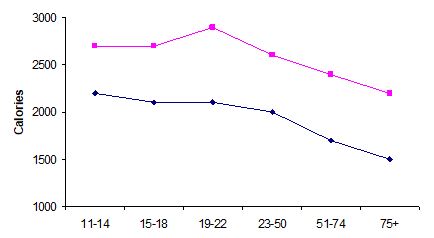Free radicals damage cells by:
A) Destroying phospholipids in the cell membrane
B) Altering the immune response of the cell
C) Disrupting calcium storage in the cell
D) Inactivation of enzymes and mitochondria
Ans: A
Feedback:
Free radicals are highly reactive and can damage cells in several ways. One way is by destroying lipids, which results in a loss of cell membrane integrity. Free radicals modify proteins but do not affect the immune function, calcium storage, or intracellular enzymes of cells.
You might also like to view...
The double-broken-line graph below shows the number of Calories per day that should be consumed by women and men in various age groups. Men should consume more Calories than women. What is the difference between the number of Calories recommended for men and the number recommended for women 19-22 years of age?

A) 600 Calories
B) 500 Calories
C) 800 Calories
D) 1000 Calories
E) 1200 Calories
Advocacy for physical activity happens only at the national level with policy statements such as the U.S. National Physical Activity Plan.
Answer the following statement true (T) or false (F)
Which statement is FALSE regarding the relationship between alcohol and aggression?
A. Alcohol is often found in the blood of both victims and perpetrators. B. About 35% of all arrests happen for drug and alcohol related offenses. C. Alcohol use has been shown to contribute to physical and sexual abuse. D. In excess, alcohol can exacerbate antisocial personality disorder.
"A flow characterized by smooth, parallel layers of fluid" is the definition of which of the following?
A. turbulent flow B. laminar flow C. relative velocity D. none of these answers is correct